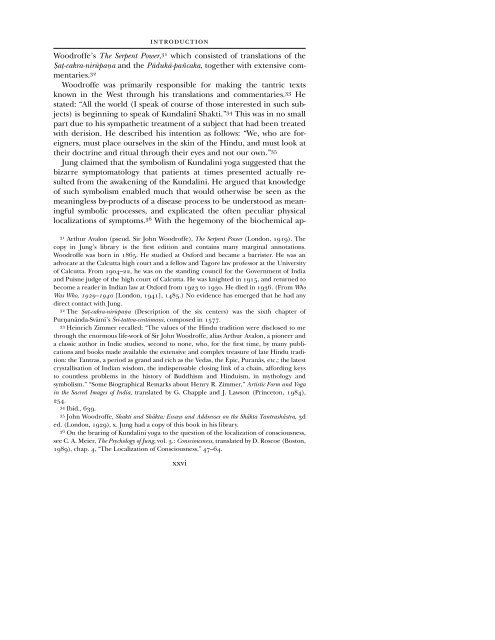CG JUNG - Countryside Anarchist
CG JUNG - Countryside Anarchist
CG JUNG - Countryside Anarchist
You also want an ePaper? Increase the reach of your titles
YUMPU automatically turns print PDFs into web optimized ePapers that Google loves.
INTRODUCTION<br />
Woodroffe’s The Serpent Power, 31 which consisted of translations of the<br />
ûa°-cakra-nirÖpaõa and the Pvdukv-pañcaka, together with extensive commentaries.<br />
32<br />
Woodroffe was primarily responsible for making the tantric texts<br />
known in the West through his translations and commentaries. 33 He<br />
stated: “All the world (I speak of course of those interested in such subjects)<br />
is beginning to speak of Kundalinî Shakti.” 34 This was in no small<br />
part due to his sympathetic treatment of a subject that had been treated<br />
with derision. He described his intention as follows: “We, who are foreigners,<br />
must place ourselves in the skin of the Hindu, and must look at<br />
their doctrine and ritual through their eyes and not our own.” 35<br />
Jung claimed that the symbolism of Kundalini yoga suggested that the<br />
bizarre symptomatology that patients at times presented actually resulted<br />
from the awakening of the Kundalini. He argued that knowledge<br />
of such symbolism enabled much that would otherwise be seen as the<br />
meaningless by-products of a disease process to be understood as meaningful<br />
symbolic processes, and explicated the often peculiar physical<br />
localizations of symptoms. 36 With the hegemony of the biochemical ap-<br />
31 Arthur Avalon (pseud. Sir John Woodroffe), The Serpent Power (London, 1919). The<br />
copy in Jung’s library is the first edition and contains many marginal annotations.<br />
Woodroffe was born in 1865. He studied at Oxford and became a barrister. He was an<br />
advocate at the Calcutta high court and a fellow and Tagore law professor at the University<br />
of Calcutta. From 1904–22, he was on the standing council for the Government of India<br />
and Puisne judge of the high court of Calcutta. He was knighted in 1915, and returned to<br />
become a reader in Indian law at Oxford from 1923 to 1930. He died in 1936. (From Who<br />
Was Who, 1929–1940 [London, 1941], 1485.) No evidence has emerged that he had any<br />
direct contact with Jung.<br />
32 The ûa°-cakra-nirÖpaõa (Description of the six centers) was the sixth chapter of<br />
Purõanvnda-Svvmz’s åri-tattva-cintvmaõz, composed in 1577.<br />
33 Heinrich Zimmer recalled: “The values of the Hindu tradition were disclosed to me<br />
through the enormous life-work of Sir John Woodroffe, alias Arthur Avalon, a pioneer and<br />
a classic author in Indic studies, second to none, who, for the first time, by many publications<br />
and books made available the extensive and complex treasure of late Hindu tradition:<br />
the Tantras, a period as grand and rich as the Vedas, the Epic, Puranâs, etc.; the latest<br />
crystallisation of Indian wisdom, the indispensable closing link of a chain, affording keys<br />
to countless problems in the history of Buddhism and Hinduism, in mythology and<br />
symbolism.” “Some Biographical Remarks about Henry R. Zimmer,” Artistic Form and Yoga<br />
in the Sacred Images of India, translated by G. Chapple and J. Lawson (Princeton, 1984),<br />
254.<br />
34 Ibid., 639.<br />
35 John Woodroffe, Shakti and Shâkta: Essays and Addresses on the Shâkta Tantrashâstra, 3d<br />
ed. (London, 1929), x. Jung had a copy of this book in his library.<br />
36 On the bearing of Kundalini yoga to the question of the localization of consciousness,<br />
see C. A. Meier, The Psychology of Jung, vol. 3.: Consciousness, translated by D. Roscoe (Boston,<br />
1989), chap. 4, “The Localization of Consciousness,” 47–64.<br />
xxvi


